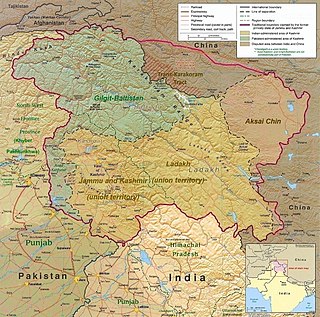
The history of Kashmir is intertwined with the history of the broader Indian subcontinent in South Asia with influences from the surrounding regions of Central, and East Asia. Historically, Kashmir referred to only the Kashmir Valley of the western Himalayas. Today, it denotes a larger area that includes the Indian-administered union territories of Jammu and Kashmir, Ladakh, the Pakistan-administered territories of Azad Kashmir and Gilgit-Baltistan, and the Chinese-administered regions of Aksai Chin and the Trans-Karakoram Tract.

A ceasefire, also spelled cease-fire, is a stoppage of a war in which each side agrees with the other to suspend aggressive actions often due to mediation by a third party. Ceasefires may be between state actors or involve non-state actors.
The Karachi Agreement of 1949 was signed by the military representatives of India and Pakistan, supervised by the United Nations Commission for India and Pakistan, establishing a cease-fire line in Kashmir following the Indo-Pakistani War of 1947. It established a cease-fire line which has been monitored by United Nations observers from the United Nations since then.

The Kashmir conflict is a territorial conflict over the Kashmir region, primarily between India and Pakistan, and also between China and India in the northeastern portion of the region. The conflict started after the partition of India in 1947 as both India and Pakistan claimed the entirety of the former princely state of Jammu and Kashmir. It is a dispute over the region that escalated into three wars between India and Pakistan and several other armed skirmishes. India controls approximately 55% of the land area of the region that includes Jammu, the Kashmir Valley, most of Ladakh, the Siachen Glacier, and 70% of its population; Pakistan controls approximately 30% of the land area that includes Azad Kashmir and Gilgit-Baltistan; and China controls the remaining 15% of the land area that includes the Aksai Chin region, the mostly uninhabited Trans-Karakoram Tract, and part of the Demchok sector.
The following is a timeline of the Kashmir conflict, a territorial conflict between India, Pakistan and, to a lesser degree, China. India and Pakistan have been involved in four wars and several border skirmishes over the issue.

In February 1948, the princely state of Junagadh, located in what is now the Indian state of Gujarat, was annexed to the Union of India after a dispute with the Dominion of Pakistan, regarding its accession, and a plebiscite. Junagadh had been a princely state under the suzerainty of the British Crown, until independence and partition of British India in 1947.

The United Nations has played an advisory role in maintaining peace and order in the Kashmir region soon after the independence and partition of British India into the dominions of Pakistan and India in 1947, when a dispute erupted between the two new States on the question of accession over the princely state of Jammu and Kashmir. India took this matter to the UN Security Council, which passed resolution 39 (1948) and established the United Nations Commission for India and Pakistan (UNCIP) to investigate the issues and mediate between the two new countries. Following the cease-fire of hostilities, it also established the United Nations Military Observer Group in India and Pakistan (UNMOGIP) to monitor the cease-fire line.

United Nations Security Council Resolution 39, adopted on January 20, 1948, offered to assist in the peaceful resolution of the Kashmir Conflict by setting up a commission of three members; one to be chosen by India, one to be chosen by Pakistan and the third to be chosen by the other two members of the commission. The commission was to write a joint letter advising the Security Council on what course of action would be best to help further peace in the region.

United Nations Security Council Resolution 47, adopted on 21 April 1948, concerns the resolution of the Kashmir conflict. After hearing arguments from both India and Pakistan, the Council increased the size of the UN Commission created by the former Resolution 39 to five members, instructed the Commission to go to the subcontinent and help the governments of India and Pakistan restore peace and order to the region and prepare for a plebiscite to decide the fate of Kashmir.

United Nations Security Council Resolution 80, adopted on March 14, 1950, having received the reports of the Commission for India and Pakistan, as well as a report from General A. G. L. McNaughton, the Council commended India and Pakistan for their compliance with the ceasefire and for the demilitarization of Jammu and Kashmir and agreement on Fleet Admiral Chester W. Nimitz as the future Plebiscite Administrator.

United Nations Security Council Resolution 96, adopted on November 10, 1951, having received a report by Mr. Frank Graham, the United Nations representative for India and Pakistan, as well as hearing his speech before the Council a basis for a program of demilitarization was noted with approval. The Council noted with gratification the declaration by both India and Pakistan that they would work for a peaceful settlement, continue to observe a cease-fire and accepted the principle that the accession of the State of Jammu and Kashmir should be determined by a free and impartial plebiscite under the auspices of the United Nations. The Council then instructed the UN Representative to continue in his efforts to obtain agreement of the parties on a plan for effecting the demilitarization of the State of Jammu and Kashmir and to report back on his efforts together with his view concerning the problems confided to him within six weeks.

United Nations Security Council Resolution 98, adopted on December 23, 1952, urged the Governments of India and Pakistan to enter into immediate negotiations under the auspices of the United Nations Representative for India and Pakistan in order to reach an agreement on the specific number of troops to remain of each side of the cease-fire line at the end of the previously established period of demilitarization. As proposed by the UN Representative this number was to be between 6000 Azad forces and 3500 Gilgit and northern scouts on the Pakistani side and 18000 Indian forces and 6000 local state forces on the Indian side. The resolution then thanked the UN Representative for his efforts, requested the Governments of India and Pakistan report to the Council no later than 30 days after the adoption of this resolution and asked the UN Representative to keep the Council informed of any progress.

United Nations Security Council Resolution 122 was adopted on 24 January 1957 and concerned the dispute between the governments of India and Pakistan over the territories of Jammu and Kashmir. It was the first of three security resolutions in 1957 to deal with the dispute between the countries. The resolution declares that the assembly proposed by the Jammu and Kashmir National Conference could not constitute a solution to the problem as defined in United Nations Security Council Resolution 91 which had been adopted almost six years earlier.

United Nations Security Council Resolution 126 was adopted on 2 December 1957. It was the last of three resolutions passed during 1957 to deal with the dispute between the governments of India and Pakistan over the territories of Jammu and Kashmir. It followed a report on the situation by Gunnar Jarring, representative for Sweden which the council had requested in resolution 123. It requests that the governments of India and Pakistan refrain from aggravating the situation, and instructs the United Nations Representative for India and Pakistan to visit the subcontinent and report to the council with recommended action toward further progress.

The Jammu and Kashmir Constituent Assembly was a body of representatives elected in 1951 to formulate the constitution of Jammu and Kashmir. The Constituent Assembly was dissolved on 26 January 1957, based on Mir Qasim resolution it adopted and ratified the constitution of jammu and kashmir on 17 November 1956.

Mohammad Abbas Ansari was a separatist political leader and a well known Shia Muslim scholar, reformer, preacher and cleric from Indian-administered Jammu and Kashmir. He was known for his religious lectures and as a Kashmiri separatist, ex-chairman of the All Parties Hurriyat Conference, also founder and chairman of the Ittihadul Muslimeen also known as Jammu & Kashmir Ittihadul Muslimeen (JKIM), a Kashmiri nationalist Shia separatist political party which aims for Shi'a–Sunni unity in Kashmir & independence of Jammu and Kashmir from India through peaceful struggle. He is considered a moderate and has called for an end to violence in that region. He is Succeeded by his son Maulana Masroor Abbas Ansari.
The All Jammu and Kashmir Plebiscite Front, or Plebiscite Front, was a political party in the Indian state of Jammu and Kashmir that called for a "popular plebiscite" to decide if the state should remain part of India, join Pakistan or become independent. The patron of the party was Sheikh Abdullah, the former Prime Minister of Jammu and Kashmir and chief of the Jammu and Kashmir National Conference, even though he never formally joined it. The founder of the party was Mirza Afzal Beg.
Pakistan officially joined the United Nations (UN) on 30 September 1947 just over a month after it came into existence. Today, it is a charter member and participates in all of the UN's specialised agencies and organisations. Pakistan has been elected seven times into the UN Security Council, with the most recent term in 2025. It is also one of the countries which has had a diplomat, Muhammad Zafarullah Khan, serve a term as the President of the United Nations General Assembly.

The history of Azad Kashmir, a disputed part of the Kashmir region currently administered by Pakistan, is related to the history of the Kashmir region during the Dogra rule. Azad Kashmir borders the Pakistani provinces of Punjab and Khyber Pakhtunkhwa to the south and west respectively, Gilgit–Baltistan to the north, and the Indian union territory of Jammu and Kashmir to the east. The region is claimed by India and has been the subject of a dispute between India and Pakistan since 1947.
The Delhi Agreement, sometimes referred to as the Nehru–Abdullah Agreement, was a political accord between the government of India and the Jammu and Kashmir Constituent Assembly government led by Sheikh Abdullah. Signed between Sheikh Abdullah, the prime minister of Jammu and Kashmir, and Jawaharlal Nehru, the prime minister of India in 1952, it aimed to determine the constitutional relationship between the Indian union and the Jammu and Kashmir, following the accession to India in 1947 under specific conditions. The Agreement, which, according to some sources such as The Tribune, was literally a political understanding that formed the foundation for Article 370, creating a constitutional framework designed to balance Kashmir's autonomy with India's sovereignty while addressing matters such as citizenship, sovereignty, and legal jurisdiction.











